Installing vinyl flooring in a bathroom can completely transform the space, providing a fresh and modern look. One common concern for many homeowners is whether to remove the toilet to complete the installation. Fortunately, installing vinyl flooring without taking out the toilet is possible, making the process simpler and more convenient.
This guide will walk you through a step-by-step process to help you install vinyl flooring around your toilet, saving time and avoiding plumbing work. By following these clear and practical steps, you’ll achieve a professional finish while maintaining the integrity of your bathroom’s fixtures. Keep reading to learn the best techniques, tools, and tips for a seamless vinyl flooring installation.
Why Choose Vinyl Flooring for Your Bathroom?
When it comes to bathroom flooring, vinyl is a top contender, and for good reason! Here are a few key reasons why vinyl flooring is a fantastic choice for your bathroom:
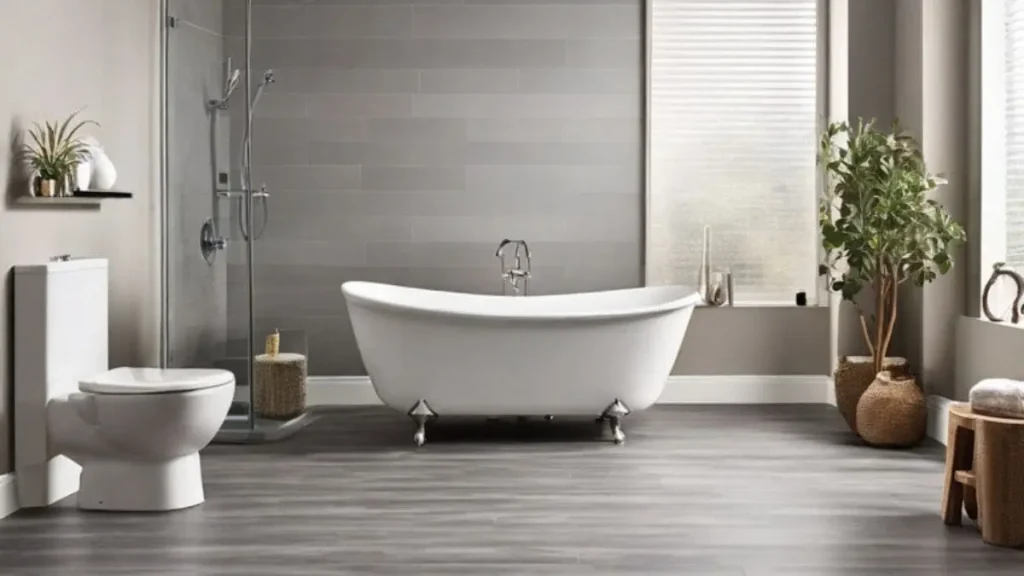
Durability & Water Resistance
Bathrooms are high-moisture areas, and you need a floor that can stand up to the challenge. Vinyl flooring is naturally water-resistant, making it perfect for spaces prone to spills, splashes, and humidity. You won’t have to worry about water damage or warping over time, unlike wood or laminate flooring.
Affordability & Style Options
On a budget? No problem! Vinyl flooring is one of the most cost-effective options on the market. But don’t let the price fool you—vinyl comes in a wide variety of colors, patterns, and textures, so you can get the look of high-end materials like hardwood or tile without the hefty price tag. Plus, it’s easy to find a style that matches your bathroom’s vibe.
Ease of Installation
One of the best things about vinyl flooring is how easy it is to install—especially if you’re looking to avoid the headache of removing your toilet. Vinyl planks or sheets are flexible, lightweight, and can be cut to fit around your bathroom fixtures. For DIYers, this means a quick, straightforward project that doesn’t require professional help.
The end of this guide, you’ll see why vinyl flooring is the go-to choice for so many homeowners, and how you can install it in your bathroom without ever touching that toilet!
Tools and Materials You’ll Need
Before starting the vinyl flooring installation in your bathroom, it’s essential to gather all the necessary tools and materials. Having everything prepared in advance ensures a smooth process without unnecessary interruptions.
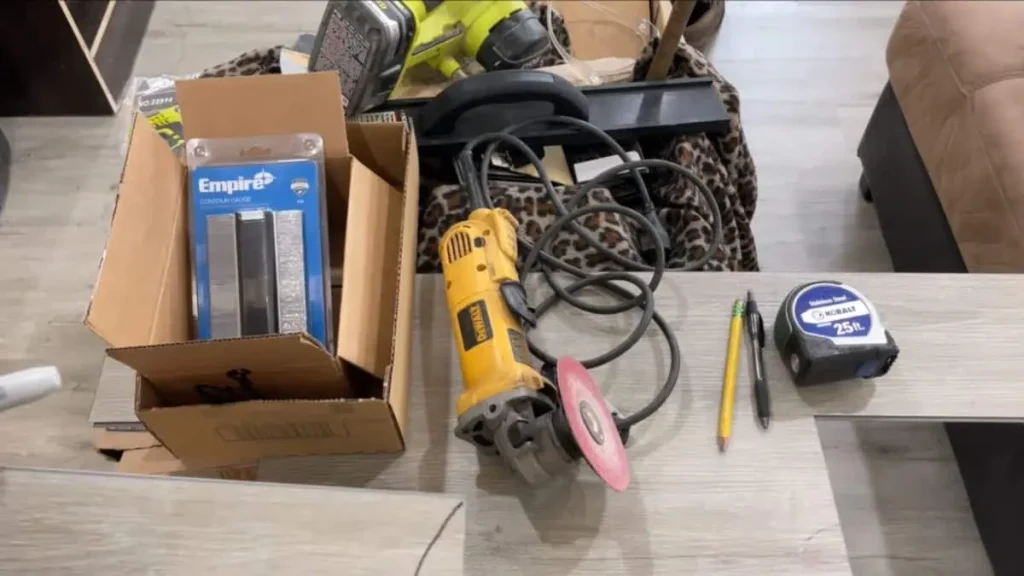
What Tools Are Required for Installing Vinyl Flooring Around a Toilet?
To install vinyl flooring efficiently without removing the toilet, you’ll need the following tools:
- Utility knife: For precise cutting of the vinyl sheets or planks.
- Measuring tape: Ensures accurate measurements for fitting the vinyl around the toilet and edges.
- Straight edge or T-square: Helps achieve straight cuts for a clean finish.
- Vinyl flooring roller: Assists in securing the vinyl and eliminating air bubbles after installation.
- Floor scraper or putty knife: Removes debris, adhesive, or old flooring materials to create a smooth surface.
- Caulk gun and silicone caulk: Seals edges around the toilet base to prevent water from seeping under the vinyl.
- Pencil or chalk: For marking cut lines on the vinyl.
These tools will help you complete the job effectively, ensuring precise measurements and clean finishes.
What Materials Are Needed for a Successful Vinyl Floor Installation?
Alongside the tools, the right materials are critical for a long-lasting vinyl floor installation. You’ll need:
- Vinyl flooring (sheets or planks): Select durable, water-resistant vinyl flooring designed for bathroom environments. Choose a design that complements your bathroom’s style.
- Adhesive or double-sided flooring tape: Ensures the vinyl flooring stays in place, especially in high-traffic areas like bathrooms.
- Underlayment (if needed): Depending on your bathroom floor’s condition, underlayment may be required for added cushion and smoothness.
- Toilet flange extender: Helps raise the toilet flange to match the height of the new flooring, ensuring a proper seal.
- Trim or transition strips: For finishing edges where the vinyl flooring meets other flooring types, like tile or carpet.
Preparation Before Installation
Proper preparation is crucial before installing vinyl flooring in a bathroom. Taking the time to ready the space and materials ensures that your installation is smooth and long-lasting. Without proper preparation, issues like uneven floors or poor adhesion can arise, causing complications during or after the installation.
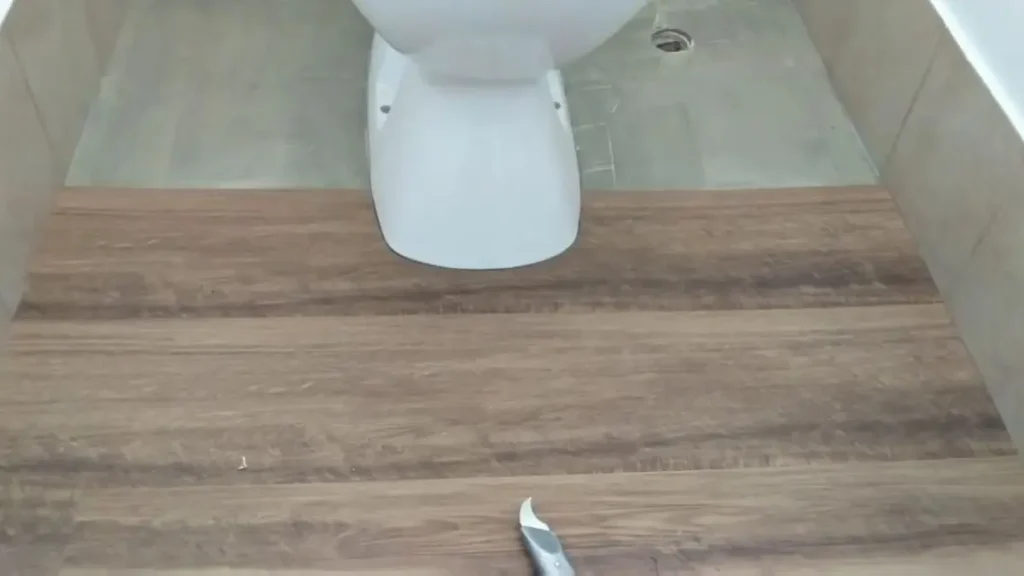
How Should You Prepare the Bathroom Floor?
The first step in preparing your bathroom is to clean and smooth the floor surface. Start by removing any existing floor coverings, such as old vinyl, tile, or laminate. Once the old flooring is removed, thoroughly clean the surface. Dust, dirt, and adhesive residues can interfere with the vinyl’s adhesion, so use a scraper or putty knife to get rid of any remaining debris.
Next, inspect the floor for imperfections. Check for cracks, dips, or uneven areas that may affect the vinyl’s appearance and durability. If the floor is uneven, consider applying a leveling compound to create a smooth, flat surface. This step is essential to avoid any bumps or gaps under the new vinyl.
Finally, ensure the bathroom floor is completely dry before moving on to the next step. Moisture trapped beneath the vinyl can lead to mold growth or cause the adhesive to fail over time.
How to Measure the Area for Vinyl Flooring?
Accurate measurements are essential when installing vinyl flooring, especially when working around fixed objects like toilets. Begin by measuring the entire bathroom floor area, noting both the total square footage and specific areas around the toilet base and any other obstacles.
Use a measuring tape to measure the width and length of the room, as well as the distance from the walls to the toilet and other fixtures. For precision, measure multiple times to ensure accuracy, as mistakes here can lead to incorrect cuts later.
Once you have your measurements, transfer them to the vinyl flooring material. It’s helpful to leave an extra inch around the edges when cutting the vinyl, as this gives you room to make adjustments as you fit the material into place.
Should the Toilet Be Removed for Vinyl Floor Installation?
One of the most common questions when installing vinyl flooring is whether the toilet needs to be removed. The good news is that you can install vinyl flooring without taking out the toilet, making the process faster and simpler.
However, it is crucial to pay special attention to the area around the toilet base. Vinyl needs to be cut precisely to fit around the toilet, ensuring no gaps where water could seep underneath. Using a heat gun can make the vinyl more flexible, allowing you to mold it closely to the toilet’s shape.
To secure the edges around the toilet, apply silicone caulk to seal the gaps. This will prevent water from getting underneath the vinyl and causing damage. By following this method, you can avoid the extra labor and hassle of removing and reinstalling the toilet.
How to Protect the Toilet and Other Fixtures During Installation?
While you won’t be removing the toilet, it’s important to protect it, as well as other fixtures like sinks and bathtubs, during the installation process. Start by covering the toilet base with painter’s tape to protect it from adhesive or scratches while cutting and fitting the vinyl.
For additional protection, cover the surrounding area with plastic sheeting or drop cloths. This step helps prevent damage to the fixtures or existing surfaces during the cutting and fitting stages.
Protecting the fixtures ensures that your installation remains clean and professional, without the risk of accidental damage to the bathroom’s features.
Step-by-Step Guide to Installing Vinyl Flooring Without Removing the Toilet
Installing vinyl flooring in a bathroom can seem challenging, especially when working around fixed fixtures like the toilet. However, with careful planning and execution, you can achieve a professional-looking result without the hassle of removing the toilet. Follow this step-by-step guide to ensure a seamless installation.
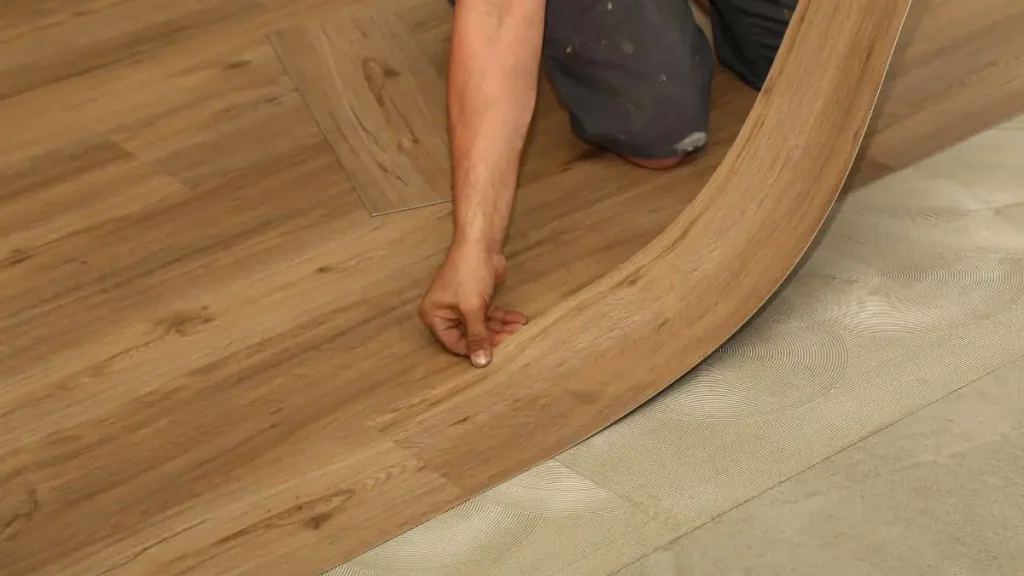
Step-1: Cutting Vinyl to Fit Around the Toilet
The key to a successful vinyl installation without removing the toilet is precise cutting around the toilet base. Start by laying the vinyl sheet over the bathroom floor to dry fit it. Ensure the vinyl is positioned correctly, and all corners align with the walls.
Once the vinyl is laid, gently press it around the base of the toilet to create a rough outline. Use a utility knife or vinyl cutter to carefully cut along this outline. It’s best to cut slightly outside the line, allowing room for adjustments as needed.
For more flexibility in tight areas, consider using a heat gun to warm the vinyl, making it easier to manipulate around curves or awkward spaces. This step ensures the vinyl fits snugly around the toilet base, giving a clean and finished appearance.
Step-2: How to Secure Vinyl Flooring Without Adhesive
One of the advantages of vinyl flooring is that it can often be installed without adhesive, using a “floating” method. This method is ideal for smaller spaces like bathrooms, as the vinyl will stay in place due to the weight of fixtures and furniture.
After cutting the vinyl to size, lay it flat on the bathroom floor. Smooth out any wrinkles or bubbles, starting from the center and working your way to the edges. Use a roller or heavy object to press the vinyl down, ensuring that it adheres to the subfloor naturally.
In areas where the vinyl may shift or lift, such as around the toilet or the edges of the room, consider using double-sided tape to secure the edges. This step provides extra stability without the mess of applying adhesive over the entire floor.
Step-3: Fitting Vinyl Around Bathroom Fixtures
When working in a bathroom, there are likely other fixtures you’ll need to navigate, such as sinks, bathtubs, and vanities. Each fixture will require careful cutting to ensure the vinyl fits snugly and creates a polished look.
For fixtures like sinks or vanities with legs, you’ll need to cut precise holes or slots into the vinyl. Use your measurements from the preparation stage to guide these cuts, and always cut slightly larger than the measurements to allow for adjustments during fitting.
Press the vinyl into place around each fixture, and use a utility knife to trim any excess material. Smooth the vinyl around curves and edges, using a heat gun if necessary to mold it into place. This technique ensures that the vinyl fits tightly and uniformly around all fixtures, preventing gaps or bulges.
Step-4: Sealing the Edges for Water Resistance
Bathrooms are high-moisture environments, so it’s critical to seal the edges of the vinyl flooring to prevent water damage. Once the vinyl is cut and fitted around the toilet and other fixtures, use silicone caulk to seal any gaps.
Apply a thin, even bead of caulk around the base of the toilet, the edges of the vinyl, and any other areas where moisture might seep underneath the floor. The caulk acts as a barrier, keeping water from reaching the subfloor and prolonging the life of the vinyl.
Smooth the caulk with a caulking tool or your finger to create a clean, professional finish. Allow the caulk to dry completely before using the bathroom, ensuring a strong and watertight seal.
Step-5: Final Touches for a Professional Finish
With the vinyl flooring installed and the edges sealed, it’s time for the finishing touches. Inspect the floor for any wrinkles, bubbles, or areas that may need additional smoothing. Use a roller to flatten any remaining imperfections, and trim any excess material along the walls or fixtures.
For a more polished appearance, consider installing baseboards or quarter round molding along the edges of the room. This not only hides any minor imperfections but also secures the vinyl further, preventing it from shifting over time.
Once the installation is complete, clean the floor thoroughly to remove any dust or debris. Your new vinyl flooring is now ready to use, providing a durable and water-resistant surface that will stand up to the demands of a bathroom environment.
Recommended: How to Install Vinyl Flooring Around a Floor Drain
Common Mistakes to Avoid
When installing vinyl flooring in a bathroom, particularly without removing the toilet, several common pitfalls can complicate the process or reduce the quality of the final result.
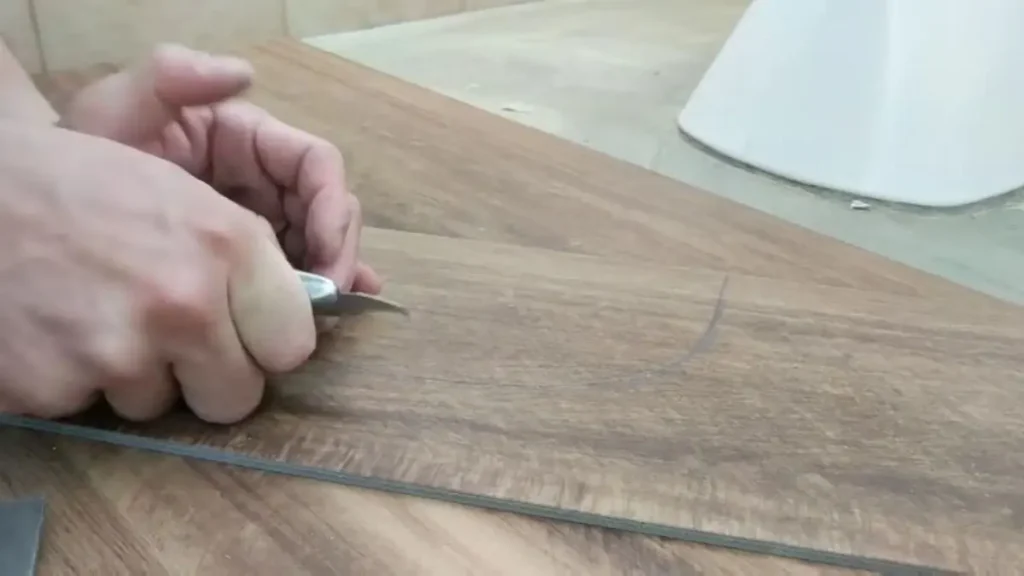
Incorrect Measurements
One of the most frequent mistakes when installing vinyl flooring is inaccurate measurements. In a small and intricately shaped space like a bathroom, even minor miscalculations can result in poor-fitting vinyl that either doesn’t cover the entire floor or has awkward gaps around fixtures.
Ensure precise measurements before cutting the vinyl, especially around complex shapes such as the base of the toilet, the bathtub, and other bathroom fixtures. Double-check the room’s dimensions and take into account any irregularities, such as curved walls or pipes, to avoid misalignment. Failing to do this can lead to unnecessary waste of material and may require costly corrections later.
Neglecting to Smooth Out Wrinkles or Bubbles
A critical mistake many DIYers make during vinyl flooring installation is failing to smooth out wrinkles or air bubbles as the vinyl is laid. These imperfections not only ruin the appearance of the floor but can also cause issues with durability and longevity. Over time, bubbles may become weak spots where the vinyl wears out more quickly or where moisture can seep underneath.
To avoid this, make sure to smooth the vinyl starting from the center of the room and working outward, using a roller or your hands to eliminate any trapped air. Carefully inspect the vinyl as you lay it down, paying special attention to areas around the toilet and other fixtures where bubbles tend to form. If you notice bubbles after the vinyl has been fully installed, using a heat gun or applying gentle pressure with a roller can help eliminate them before they cause lasting damage.
Poor Fitting Around the Toilet and Fixtures
Another common issue is improperly cutting the vinyl around the toilet and other bathroom fixtures. If the vinyl is cut too large, it can leave unsightly gaps around the toilet base, which not only affects the appearance but can also expose the subfloor to moisture. On the other hand, cutting the vinyl too small can create tension around the base of the toilet, causing the vinyl to buckle or lift over time.
To avoid this, use accurate cutting techniques, and don’t rush the process. Carefully trace the outline of the toilet and fixtures before cutting, and always cut conservatively, leaving a little extra material for fine adjustments. A heat gun can be particularly useful when fitting the vinyl around tight or curved spaces, as it allows the vinyl to mold more easily into place without tearing or bunching.
Skipping the Sealing Step
One of the most important steps in bathroom vinyl installation is sealing the edges of the flooring to prevent moisture infiltration. Skipping or inadequately performing this step can lead to water damage to the subfloor, mold growth, and premature wear of the vinyl. This is especially important around the base of the toilet, as this area is highly susceptible to moisture exposure.
Always apply a quality silicone caulk around the perimeter of the room, as well as around the toilet and any other fixtures where the vinyl meets a surface. Be sure to apply the caulk evenly and press it into gaps to create a watertight seal. Allow the caulk to fully cure before using the bathroom to ensure it forms a strong, long-lasting barrier against moisture.
Failing to Account for Bathroom Humidity
Bathrooms are humid environments, and failing to account for the effects of humidity on vinyl flooring is a common mistake. High levels of moisture in the air can cause vinyl to expand or contract slightly, and without proper installation techniques, this can lead to buckling or lifting of the floor.
To prevent this, allow the vinyl to acclimate to the bathroom environment before installation. Let the vinyl rest in the bathroom for at least 24 hours before laying it down, so it adjusts to the temperature and humidity levels of the space. Additionally, ensuring the floor is completely dry and free of debris before installation is essential to avoid trapping moisture underneath the vinyl.
Overlooking Subfloor Preparation
Installing vinyl flooring without properly preparing the subfloor is another common mistake that can lead to poor results. Any imperfections in the subfloor, such as bumps, cracks, or uneven surfaces, will transfer through the vinyl, creating visible defects. Over time, these flaws can compromise the integrity of the floor, causing it to wear unevenly or even tear.
Before laying the vinyl, thoroughly clean the subfloor and check for any damage or unevenness. If necessary, use a leveling compound to smooth out the surface, and ensure that the subfloor is completely dry before installation. Skipping this step can lead to significant issues down the road, so take the time to prepare the subfloor properly to ensure a smooth, durable finish for your vinyl flooring.
Practical Tips for DIYers
Installing vinyl flooring in a bathroom without removing the toilet can be a manageable project for DIYers, provided you approach it with the right knowledge and preparation. Here are practical tips to help you achieve a successful installation.

Take Your Time
One of the most important pieces of advice for DIYers is to take your time during the installation process. Rushing through the project can lead to mistakes, such as inaccurate measurements or poorly cut vinyl. Carefully plan each step, allowing ample time for preparation and installation. This ensures that you achieve the best possible results and can troubleshoot any issues that may arise without feeling pressured.
Utilize Proper Cutting Techniques
When cutting the vinyl to fit around the toilet and other fixtures, employing the right techniques is essential. Use a sharp utility knife for clean cuts, as a dull blade can create jagged edges that look unprofessional. Additionally, always cut on a flat, stable surface to maintain control over the cutting process. To ensure accurate fits, make small, incremental cuts rather than attempting to remove large sections of material at once. This method allows for adjustments and minimizes the risk of cutting too much vinyl.
Prepare the Bathroom Environment
Before starting your installation, create an optimal environment for working with vinyl flooring. Ensure the bathroom is at a comfortable temperature, ideally between 65°F and 85°F, as this helps the vinyl become more pliable and easier to work with. Adequate ventilation is also crucial, especially if you are using adhesives. Open windows or use fans to circulate air and minimize any potential buildup of fumes from adhesives or sealants.
Invest in Quality Materials
Choosing high-quality vinyl flooring and materials is key to a successful installation and long-lasting results. Low-quality vinyl may be more affordable, but it often lacks durability and can wear out more quickly, leading to costly repairs down the line. Opt for reputable brands that offer warranties and guarantees on their products. Additionally, using a quality underlayment can improve comfort, insulation, and sound absorption, enhancing the overall performance of your vinyl flooring.
Use a Roller for Even Adhesion
After laying down the vinyl, it is crucial to ensure proper adhesion, especially in areas around the toilet where movement may occur. Using a flooring roller can help press the vinyl evenly against the subfloor, eliminating air pockets and ensuring a secure bond. Roll the vinyl starting from the center and moving outward to avoid trapping air. This technique helps to achieve a smooth, flat surface free from bubbles and imperfections, enhancing the overall aesthetic of your bathroom flooring.
Maintain the Installation
After installing your vinyl flooring, regular maintenance is essential to keep it looking its best. Keep the floor clean by sweeping or vacuuming regularly to remove dirt and debris that can cause scratches. Use a damp mop with a gentle cleaning solution specifically formulated for vinyl flooring to avoid damage. Additionally, protect the floor from heavy furniture and sharp objects that can create dents or tears. By maintaining your flooring, you can extend its lifespan and preserve its appearance.
Seek Help When Needed
If you encounter challenges during the installation process or feel uncertain about specific steps, do not hesitate to seek assistance. Consulting with experienced friends, family, or professionals can provide valuable insights and guidance. Online tutorials and forums can also be helpful resources for troubleshooting common issues. Understanding when to ask for help ensures you achieve the best results while avoiding unnecessary frustration or mistakes.
Conclusion
Installing vinyl flooring in a bathroom without removing the toilet is a feasible project that can significantly enhance the space’s aesthetics and functionality. By following the outlined steps and utilizing the right tools and materials, DIYers can achieve a professional-looking installation. Preparation is crucial, from ensuring a clean work environment to accurately measuring and cutting the vinyl. Avoiding common mistakes and implementing practical tips will contribute to a successful outcome.
Remember, patience is key throughout the installation process. Taking your time allows for careful execution and attention to detail, leading to a durable and visually appealing result. With proper maintenance, your new vinyl flooring can provide lasting beauty and ease of cleaning, making your bathroom a more enjoyable space for years to come. Embrace the project with confidence, and transform your bathroom into a stylish haven.



